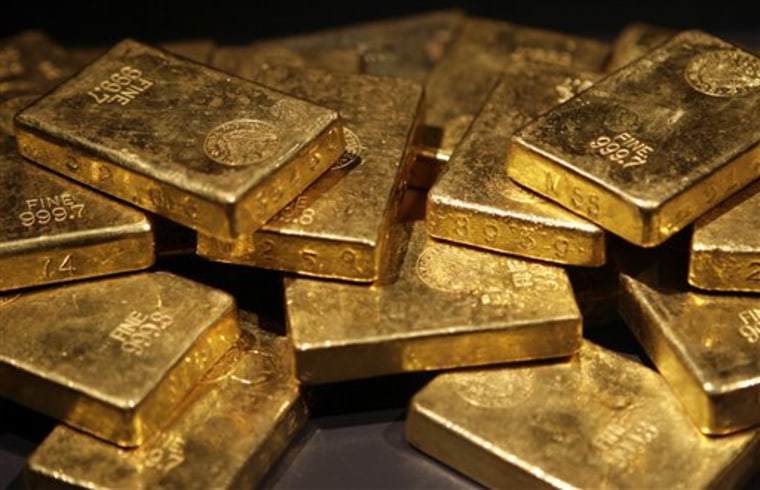Customers who step into the offices of Heritage West Financial in San Diego have always favored gold as an investment on paper, a place to park their money. But in the past few years, Ralph Weston began to notice a change in his clients' orders.
They wanted to take the 33-ounce blocks home with them.
"I don't know what they do with it," said Weston, a market analyst. "Do they use it as a doorstop or what?"
The price of gold keeps going up, setting records week after week.
Gold rallied to record highs in Europe on Friday, with spot prices knocking on the door of $1,300 an ounce, as expectations grew that further quantitative easing could lead to volatility in the currency markets.
On Thursday it touched yet another new high, trading at $1,296.30 an ounce. Just two years ago, it was trading at about $900.
Low interest rates, a falling dollar and anxiety over holding government debt have prompted investors and central banks alike to buy the metal — something tangible instead of a promise.
To Weston, the gold rush reflects his clients' diminishing trust in Wall Street and the federal government. Gold has fans in the tea party movement and among viewers of conservative cable-talk host Glenn Beck, who touts it on his show.
In financial circles, analysts credit the rising price of gold to an unlikely duo: investors seeking shelter and central bankers from India, Bangladesh and other developing countries. Both are wary of a falling dollar.
It starts with low interest rates. Central banks usually hold currencies from the world's largest economies — dollars, pounds and yen — and then invest them in short-term bonds.
At the moment, interest rates in the United States and other developed countries are near record lows. Currencies tend to follow the path of interest rates, so not only do central banks get little return from buying dollars, but they face the prospect of the dollar falling even further. What's the alternative?
"Historically, gold has been the last thing you sell," said Francisco Blanch, commodity strategist at Bank of America. And in times of crisis, it tends to rise.
The Federal Reserve played a role in gold's recent surge when its interest-rate committee hinted at further efforts to lower borrowing rates, said Suki Cooper, a commodity analyst at Barclays in London.
The dollar dropped after the Fed's announcement, reflecting worries that further moves would raise the risk of inflation. Earlier in the month, gold also got a boost from Bangladesh's purchase of 10 metric tons from the International Monetary Fund.
It's the same mix that has pushed gold's price higher over recent months, analysts said. When currencies or other assets fall, gold tends to go its own way, making it especially appealing to central banks.
Consider:
- Sales of the U.S. Mint's American Eagle Gold Bullion have soared. In 2005, the mint counted 449,000 ounces sold. The tally so far this year: 922,500 ounces.
- The stash of gold held by exchange-traded funds, which allow investors to buy groups of stocks and trade them like a single investment, is piling up. The 22 funds tracked by Barclays Capital hold a record 2,107 tons. That's almost a year's worth of gold mining. Annual production runs around 2,400 tons worldwide.
- China has 2 percent of its reserves in gold, or 1,000 tons, according to Barclays research. To reach 10 percent, a mark some consider ideal, China would need to buy all the gold mined in the world for two years.
To understand gold's price surge, think of it as shifting between two roles, commodity and currency, said Barclays' Cooper. When the majority of buyers use gold for jewelry and for filling teeth, it trades like a commodity and is relatively stable. In the 1990s, for instance, it traded between $300 and $400 an ounce. Gold is still well off its inflation-adjusted high. It hit $850 in ounce in 1980, which works out to about $2,250 in today's dollars.
"Now you need to look at gold as wearing its currency hat," she said. "It's a barometer of investors' concerns over the macroeconomic outlook."
The move by central banks to diversify their reserves has a massive impact on prices, according to Bank of America's commodity research team. In a recent report, the researchers called the purchases by Bangladesh, Sri Lanka and other developing countries "the new gold rush."
Bank of America expects to see gold reach $1,500 in the next year. Most scenarios seem to work in gold's favor, Blanch said. If the economic recovery takes hold and oil prices rise, or even if people expect more inflation, gold goes up, he said. A sharp jump in interest rates could pull many investors and central banks out of gold, he said.
